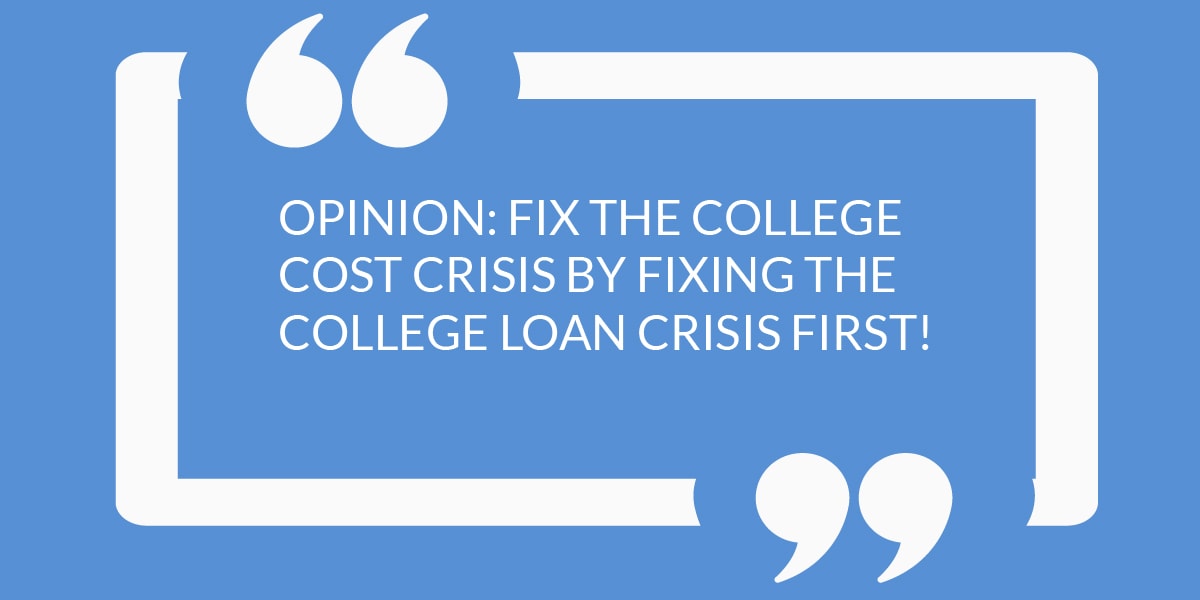OPINION: FIX THE COLLEGE COST CRISIS BY FIXING THE COLLEGE LOAN CRISIS FIRST!

The cost of a college education today has reached “crisis mode.” The cost of most large state universities are over $30,000 a year per student and some elite schools, such as Yale U, have price tags approaching $80,000 a year per student. Most families with two, or more, students cannot afford to fund their future retirement and pay for college at the same time.
You know the high cost of college is in crisis mode when politicians use it as a major election platform. They scream “free college for all” and “we’ll pay off all your student loans” at the top of their lungs. But this is a political promise, not a solution. Anyone that can balance a checking account understands that their tax bill must increase to fund any “FREE” program offered by the federal government. And this increase in taxes will make it difficult for families to fund their retirement every year in the future, not just the years their children attend college.
Is there a solution to the high cost of college? In my opinion, there is.
To fix the college cost crisis you must fix the college loan crisis first!
The federal government is very good at spending money, not collecting money. Nothing points out this statement like the education system. According to the College Board, total Pell Grant expenditures decreased from $34.3 billion in 2013-14 to $28.2 billion in 2018-19. The number of student recipients of Pell Grants also fell from 9.0 million to 7.0 million during those five years, and the majority of Pell Grant money goes to students with a total family income below $20,000.
These statistics are the exact opposite of education loans. Student loans increased from $680 billion in 2013-2014 to $1.5 trillion in 2018-2019. That’s more than double in just five years! There are currently 44.7 million student loan borrowers in the U.S., with an average debt of $32,721. The federal government holds 92% of the current $1.5 trillion student loan debt. 11.4% of the outstanding amount is in severe delinquency or default (90+ days) in 2018, according to The Office of Federal Student Aid.
Private institutions hold the 8% balance in student loans but have a 98% repayment rate. So there’s not a student loans crisis, there’s a FEDERAL student loan crisis. Therein lies the problem.
For the past few decades, the overwhelming majority of student loans were controlled by banks or private lenders. They were simply guaranteed by the federal government because the borrowers were young and had little to no credit history. But when the Great Recession hit, the feeble economy placed a considerable strain on banks and private lenders who faced a credit crunch with bad assets on the books. So President Obama organized all new loans under the Direct Loan program by July 2010. The switch to 100% Direct Lending was enacted July 1, 2010. Since then, the student loan balance has skyrocketed.
The Office of Federal Student Aid shows that over 34 million student loan borrowers hold approximately $1.2 trillion in Direct Loans. Another 13.5 million student loan borrowers hold $282 billion in Federal Family Education Loans (FFEL).
Student Loan Debt Outstanding By Student Loan Program
Federal Direct Loans: $1.150 trillion (34.2 million borrowers)
Federal Family Education Loans (FFEL): $281.8 billion (13.5 million borrowers)
TOTAL: $1,431.8 billion
As I stated above, the Federal government is not good at lending or collecting money. Over the last ten years, they have loaned money to students who made bad career decisions, attended colleges out of their price range, or should never have attended college period. Then there’s the PLUS loan issue.
The PLUS Loan Issue
PLUS loans are also a big part of the student loan crisis.
Student Loan Debt Outstanding By Student Loan Type
- Stafford Combined: $767.1 billion (33.1 million unique borrowers)
- Grad PLUS: $67.0 billion (1.3 million borrowers)
- Parent PLUS: $88.9 billion (3.6 million borrowers)
Grad students that should never have attended grad school are borrowing expensive PLUS loans. Parents that want to send their kids to a dream school way out of their price range are borrowing Parent PLUS loans with a 7% interest rate and a 4% origination fee. And they can borrow money for the full price of college with just an average credit rating. Private lenders would never allow borrowing limits like that.
Colleges will never have an incentive to lower prices with this much loose money on the market. Why would they?
This craziness would all come to a halt by putting a cap, or a limit, on the amount of PLUS loan that parents, or grad students, can borrow per year, per student. Limited borrowing would force the family to pick a college they can afford, rather than choose a school the student wants to go, regardless of the reason or cost. It would help them to be more “price-conscious,” which in turn would force colleges to rethink their price structure and make them more “cost-conscious” of their spending (tenured professors, capital projects, etc.). It’s letting the free market do its thing.
The Endless Supply of Student Loan Money Will Soon Become a Retirement Issue
As of 2017, here is the breakdown of student loan borrowers by age.
- < 30-years-old: 16.8 million
- 30-39: 12.3 million
- 40-49: 7.3 million
- 50-59: 5.2 million
- 60+: 3.2 million
What does this all tell you? A 20+-year-old student could never borrow $32,000 for an automobile but can borrow that amount for their education. A 30+-year-old student could never borrow $100,000+ for a house but can borrow that amount for their advanced education. And there are potentially over 3 million people that still maintain student loan balances into retirement.
What’s wrong with that picture?
What If the Federal Government Got Out of the Student Loan Business?
When I graduated from Ohio University in 1972 my total cost was about $10,000. My Dad paid that bill. I paid for my Masters in Accounting in 1973. My price for my Master's degree was about $5,000. I paid for that with $3,000 in summer savings and a $2,000 private loan. I took an accounting job in 1974, and my salary started at $11,500. By the end of 1974, I paid off my student loan, bought a new car, and moved out of my parents home.
That's the way the system is supposed to work. Not any more. Once the federal government got into the student loan business, the system started to go downhill. Easy money and bad student/family decisions (paying for a college the family can't afford) make it easier for colleges to keep raising their prices.
The Federal government needs to get out of the student loan business. The student loan system needs to be controlled by banks or private lenders again. This new system would soon eliminate the easy money, and colleges would soon be forced to manage their pricing.
Solving the College Cost Crisis
Can the college cost crisis be solved? You bet! Are you telling me that in a country with some of the most outstanding inventions of all time we can't come up with a better idea than FREE COLLEGE? That's ludicrous. No politician will ever win an election based on the government will "pay for everything" platform. That's simply a way to say the taxpayer will pay for college, regardless of whether they have a student in the system.
I think the current student loan and college cost crisis can be solved. Here's how:
First, the federal government needs to get out of the student loan business. Banks, credit unions, or private lenders should control student loans because they know what they’re doing. The federal government should only guarantee these loans since the borrowers have little to no credit history.
Second, there will no more “subsidized” Stafford loans. All Stafford loans will be Unsubsidized (they can be accrued after the first 60 days).
Third, all Stafford and PLUS Loans should have new limits. There will be a $30,000 per student limit on Stafford loans, and the PLUS loans should have the same $30,000 per student limit. These limits would eliminate some students from attending grad school, and medical schools would need special stipends based on academics. Harvard and the elite schools would also need to adjust there admissions and aid programs, but so be it.
Fourth, after graduation, the student’s loans are locked into a zero-interest, zero payment account (similar to the current Subsidized Stafford loan system). The student has one year to find a job without making payments on the loans. The government would subsidize the interest.
Fifth, after one year, all student loans would be placed into an income-based system at 3% of gross income and forgiven after 20 years. Loan repayments are then paid using the existing tax system, like the 1.45 Medicare deduction in the current Social Security tax. Borrowers will see an automatic deduction on their earnings, without any complicated paperwork. Using this method, if the student lost their job, or became medically incapable of working, the loan bills won’t keep coming.
In my opinion, the above five steps would put the student loan crisis back into a more controlled environment, and ultimately force colleges to put their prices in control. But that’s just my opinion.
Posted by Ron Them
He is a former Chief Financial Officer of a Fortune 500 company and currently owns his own financial advisory company specializing in cash flow planning for business owners and executives. He developed the Cash Flow Recovery™ process that uses cash flow management principals to increase asset value and build wealth for business owners.
He is also the originator of several software calculators to help advisors and families make college affordable, including:
* College QuikPlan EFC Calculator
* "Find the Money" College Cash Flow Calculator
* College Debt Reduction Calculator
Ron has been quoted in U.S. News and World Report, Kiplinger's Personal Finance, Smart Money, Financial Advisor Magazine, Small Firm Profit Report, Practical Accountant, LIMRA's Market Facts, Senior Advisors Magazine, HR Magazine, BenefitNews.com, Employee Benefit News Magazine, ProducersWeb.com, Entrepreneur Magazine, Insurance Selling Magazine, CollegeNews.com, The Christian Voice, and Columbus CEO Magazine.
